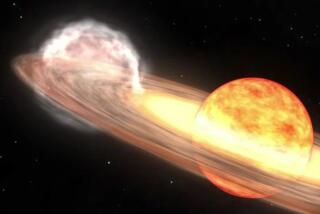Astronomers prepare for rare transit of Venus
- Share via
On June 5, astronomers will witness an astronomical event that has been observed in the modern era only six times previously, a passage or transit of the planet Venus across the face of the sun. The next time such an event will occur is 2117, so researchers are gearing up to devote as many resources as possible to view the transit from both Earth and space. Among other things, scientists hope observations of the transit will inform efforts to detect extrasolar planets -- those around distant stars -- a feat that is achieved in part by observing the dimming of a star as a planet passes between it and the Earth.
Venus’ orbit around the sun lies in a slightly different plane than the Earth’s, so transits occur only rarely and in pairs. The cycle of transits is 243 years long, with intervals of 8, 105.5, 8 and 120.5 years. The last transit was in 2004 and was also heavily observed, but the upcoming transit will be the first in which astronomers also have a satellite, the Venus Express, in orbit around the planet.
The first known transit of Venus was predicted for Dec. 7, 1631 by the German astronomer Johannes Kepler, but he died before the transit occurred. The next one, eight years later, was observed by only two individuals in England, Jeremiah Horrocks and William Crabtree. By the next transit in 1761, early scientists had realized that observations of it could help establish the size of the solar system. Expeditions, including one by Capt. James Cook, were sent around the world to monitor the event. By precisely timing the beginning and end of the transit from many locations on Earth, astronomers hoped to use simple triangulation to calculate the distances to Venus and the sun. But the so-called black-drop effect, in which a black spot appeared between the planet and the sun prior to their merging, made precise measurements virtually impossible, and calculations provided only very rough estimates. In the transits of 1761 and 1769, however, astronomers noticed a halo of light around the planet, indicating that Venus has an atmosphere.
The next pair of transits in 1874 and 1882 were more heavily studied, with the U.S. alone organizing eight expeditions equipped with state-of-the-art instruments to observe it around the world. Many of those instruments, now owned by the U.S. Naval Observatory, will be used in the coming observations.
Observations of the 2004 transit explained the black-drop effect: it is caused by the innate blurriness of objects in a telescope and an extreme dimming of the sun’s surface just inside its apparent outer edge. The images also showed that the haze in Venus’ atmosphere is highest at the poles and lower near the planet’s equator, a surprising finding.
When Venus is fully in front of the sun, it will be visible to the naked eye -- although one should never look directly at the sun without an approved filter to block rays that could damage the eye -- but it will dim the sun’s light by only 0.1%. A similar dimming of distant stars observed by NASA’s Kepler spacecraft has identified more than 1,000 potential exoplanets, but so far only about 100 of them have been confirmed as actual planets. One problem is that the eruption of sunspots can cause a similar dimming and it can be hard to distinguish between the two events. The 2004 transit of Venus occurred at a time when sunspot activity was at a minimum, but this year’s event will be at a time when sunspot activity is fairly high. That should provide astronomers new insight into ways to distinguish between the two events.
The transit will begin about 3:04 p.m. PDT on June 5 and will be visible in its entirety only from the western Pacific, eastern Asia, eastern Australia and at high northern latitudes. The transit will be shown on NASA TV, which is available on many cable and satellite transmission systems, and on NASA TV’s website. Astronomers from the European Space Agency will also be blogging the event from a viewing site on the Arctic island of Spitsbergen.
LATimesScience@gmail.com
Twitter/@LATMaugh






